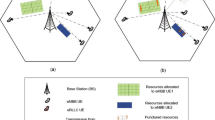Abstract
As tetherless multimedia computing environments are becoming much desired, broadband wireless communication infrastructures for providing wireless multimedia services will play an important role, and thus, are expected to proliferate. However, despite much research efforts have been expended, the multiple access control of the precious bandwidth remains a challenging problem because of the existence of two common drawbacks in the state-of-the-art protocols: (1) channel condition is ignored or not exploited, and (2) inflexible or biased time slots allocation algorithms are used. Indeed, existing protocols mostly ignore the burst errors due to fading and shadowing, which are inevitable in a mobile and wireless communication environment. A few protocols take into account the burst errors but just “handle” the errors in a passive manner. Most of the existing protocols employ an inflexible or biased allocation algorithm such that over-provisioning may occur for a certain class of users at the expense of the poor service quality received by other users. In this paper, a new MAC protocol, called SCAMA (synergistic channel adaptive multiple access) is proposed. The proposed protocol works closely with the underlying physical layer in that through observing the channel state information (CSI) of each mobile user, the MAC protocol first segregates a set of users with good CSI from requests gathered in the request contention phase of an uplink frame. The MAC protocol then judiciously allocates information time slots to the users according to the respective traffic types, CSI, urgency, and throughput, which are collectively represented by a novel and flexible priority function. Despite that contention request queue is not used in the protocol, the SCAMA protocol is robust in that it can avoid the congestion collapse which occur in other protocols.
Similar content being viewed by others
References
S.M. Alamouti and S. Kallel, Adaptive Trellis-coded multiple-phaseshift keying for Rayleigh fading channels, IEEE Transactions on Communications 42(6) (1994) 2305-2314.
J.C. Ambak and W. van Blitterswijk, Capacity of slotted ALOHA in Raleigh fading channels, IEEE Journal on Selected Areas in Communications 5(2) (1987) 261-268.
G. Anastasi, L. Lenzini and E. Mingozzi, MAC protocols for wideband wireless local access: evolution toward wireless ATM, IEEE Personal Communications (October 1998) 53-64.
E. Ayanoglu, K.Y. Eng and M.J. Karol, Wireless ATM: limits, challenges, and proposals, IEEE Personal Communications (August 1996) 18-34.
G. Falk, J.S. Groff, W.C. Milliken, M. Nodine, S. Blumenthal and W. Edmond, Integration of voice and data in the wideband packet satellite network, IEEE Journal on Selected Areas in Communications 1(6) (1983) 1076-1083.
D.J. Goodman, R.A. Valenzuela, K.T. Gayliard and B. Ramamurthi, Packet reservation multiple access for local wireless communications, IEEE Transactions on Communications 37(8) (1989) 885-890.
J. Gruber and L. Strawczynski, Subjective effects of variable delay and speech clipping in dynamically managed voice systems, IEEE Transactions on Communications 33(8) (1985) 801-808.
M.J. Karol, Z. Liu and K.Y. Eng, Distributed-queueing requests update multiple access (DQRUMA) for wireless packet (ATM) networks, in: Proceedings of INFOCOM'95 (1995) pp. 1224-1231.
M. Kawagishi, S. Sampei and N. Morinaga, A novel reservation TDMA based multiple access scheme using adaptive modulation for multimedia wireless communication systems, in: Proceedings of VTC'98 (1998) pp. 112-116.
J.G. Kim and I. Widjaja, PRMA/DA: a new media access control protocol for wireless ATM, in: Proceedings of the ICC'96 (1996) pp. 240-244.
T.V. Lakshman, A. Ortega and A.R. Reibman, VBR video: tradeoffs and potentials, Proceedings of the IEEE 86(5) (1998) 952-973.
V.K.N. Lau, Performance of variable rate bit-interleaved coding for high bandwidth efficiency, in: Proceedings of VTC'2000, Tokyo, Japan, May 2000.
V.K.N. Lau and Y.-K. Kwok, On channel adaptive multiple access control with queued transmission requests for wireless ATM, Technical Report, HKU EEE Department (December 1999).
V.K.N. Lau and S.V. Maric, Variable rate adaptive modulation for DSCDMA, IEEE Transactions on Communications 47(4) (1999) 577-589.
A. Urie, M. Streeton and C. Mourot, An advanced TDMA mobile access system for UMTS, in: Proceedings of the IEEE PIMRC'94 (1994).
M.D. Yacoub, Foundations of Mobile Radio Engineering (CRC Press, Boca Raton, FL, 1993).
Author information
Authors and Affiliations
Rights and permissions
About this article
Cite this article
Kwok, YK., Lau, V.KN. On Channel Adaptive Multiple Access Control without Contention Queue for Wireless Multimedia Services. Wireless Networks 9, 379–392 (2003). https://doi.org/10.1023/A:1023685402063
Issue Date:
DOI: https://doi.org/10.1023/A:1023685402063




